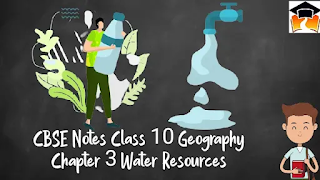Here I am going to provide you CBSE Notes Class 10 Geography Chapter 3 Water Resources. You can also Download PDF of these notes. In this chapter you will learn about water resources. The chapter begins with the availability of fresh water on earth and how the situation of scarcity of water generates. The chapter discusses the pros and cons of constructing dams on rivers. In the end, the chapter talks about Rain Water Harvesting as a means to conserve water. By going through Water Resources Class 10 Notes you will acquire a better command on this chapter. So,use these notes and do your best!!
Water
- Water is a renewable resource.
- Three-fourth of the earth’s surface is covered with water.
- But only a small proportion of it accounts for freshwater, that can be put to use.
- 96.5 percent of the total volume of world’s water is estimated to exist as oceans and only 2.5 per cent as freshwater.
- India receives nearly 4 percent of the global precipitation and ranks 133 in the world in terms of water availability per person per annum.
- By 2025, it is predicted that large parts of India will join countries or regions having absolute water scarcity.
Water Scarcity and the Need for Water Conservation and Management
- The availability of water resources varies over space and time.
- Water scarcity is caused by over-exploitation, excessive use and unequal access to water among different social groups.
- Water resources are being over-exploited to expand irrigated areas for dry-season agriculture.
- In some areas, water is sufficiently available to meet the needs of the people.
- But, those areas still suffer from water scarcity due to bad quality of water.
The need of the hour is to conserve and manage our water resources:
- To safeguard ourselves from health hazards.
- To ensure food security, continuation of our livelihoods and productive activities.
- To prevent degradation of our natural ecosystems.
Multi-Purpose River Projects and Integrated Water Resources Management
- In ancient times, we used to conserve water by constructing sophisticated hydraulic structures like dams built of stone rubble, reservoirs or lakes, embankments and canals for irrigation.
- We have continued this tradition in modern India by building dams in most of our river basins.
Dams
A dam is a barrier across flowing water that obstructs, directs or retards the flow, often creating a reservoir, lake or impoundment. “Dam” refers to the reservoir rather than the structure.
Uses of Dam:
Dams are built:
- To impound rivers and rainwater that can be used later to irrigate agricultural fields.
- For electricity generation.
- Water supply for domestic and industrial uses.
- Flood control.
- Recreation, inland navigation and fish breeding.
Side effects of Creating Dams
- Regulating and damming of rivers affect their natural flow.
- Poorer the habitats for the rivers’ aquatic life.
- Fragment rivers make it difficult for aquatic fauna to migrate.
- Dams created on the floodplains submerge the existing vegetation and soil leading to its decomposition over a period of time.
- Many times local people had to give up their land, livelihood and their control over resources for the construction of the dam.
- These projects induced earthquakes, caused water- borne diseases and pests and pollution resulting from excessive use of water.
Movements against Multi-purpose river projects
- These projects cause of many new social movements like the ‘Narmada Bachao Andolan’ and the ‘Tehri Dam Andolan’ etc.
- This is due to the large-scale displacement of local communities.
- Inter-state water disputes are also becoming common with regard to sharing the costs and benefits of the multi-purpose project.
Rain Water Harvesting
- Rainwater harvesting is a simple method by which rainfall is collected for future usage.
- The collected rainwater may be stored, utilised in different ways or directly used for recharge purposes.
Different methods have been adopted in different areas for Rain Water Harvesting:
- In hill and mountainous regions, people have built diversion channels like the ‘guls’ or ‘kuls’ of the Western Himalayas for agriculture.
- “Rooftop rainwater harvesting” is commonly practised to store drinking water, particularly in Rajasthan.
- In the flood plains of Bengal, people developed inundation channels to irrigate their fields.
- In arid and semi-arid regions, agricultural fields were converted into rain-fed storage structures that allowed the water to stand and moisten the soil such as ‘khadins’ in Jaisalmer and ‘Johads’ in other parts of Rajasthan.
How Tankas works:
- The tankas are part of the well-developed rooftop rainwater harvesting system and are built inside the main house or the courtyard.
- This is mainly practised in Rajasthan, particularly in Bikaner, Phalodi and Barmer areas for saving the rainwater.
- Many houses have constructed underground rooms adjoining the ‘tanka’ to beat the summer heat as it would keep the room cool.
- Tamil Nadu is the first state in India which has made rooftop rainwater harvesting structure compulsory to all the houses across the state. There are legal provisions to punish the defaulters.


